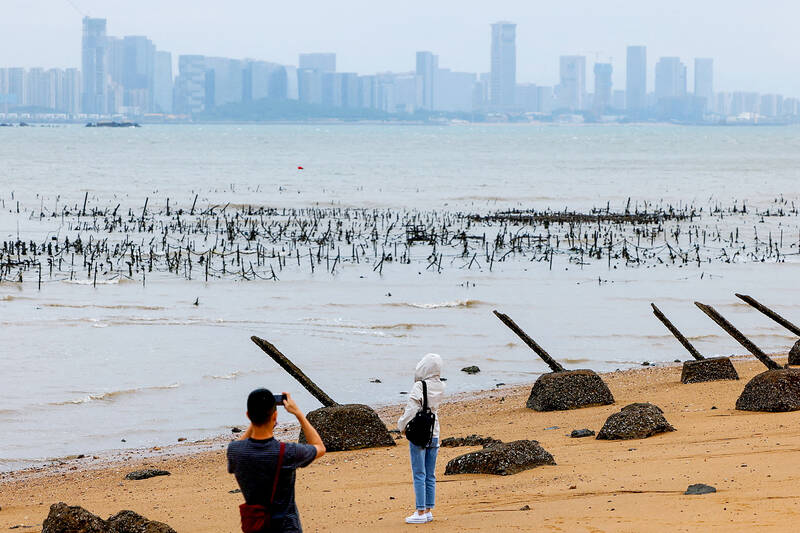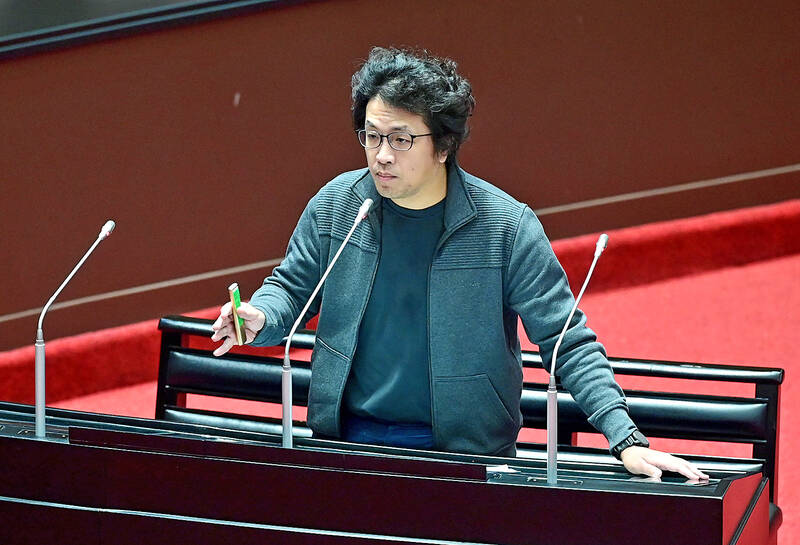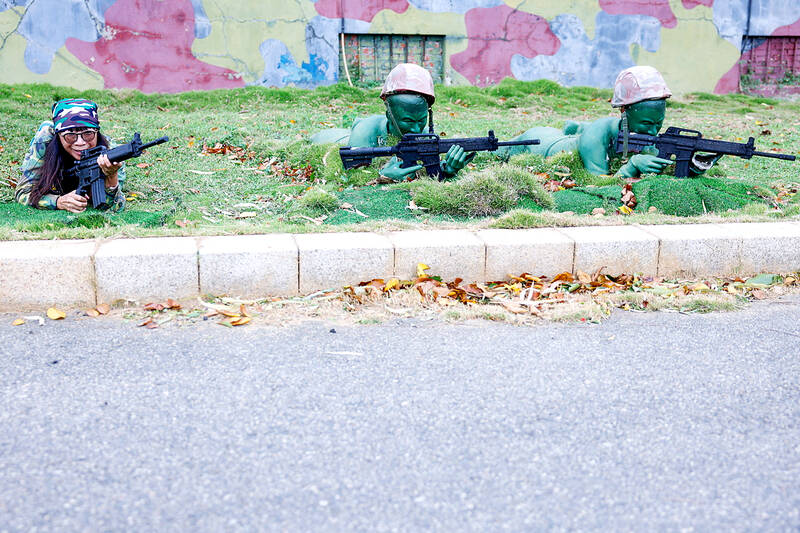The People’s Republic of China (PRC) media reported late last month that the Chongqing Municipal Public Security Bureau had opened an investigation into Democratic Progressive Party Legislator Puma Shen (沈伯洋) for “Taiwan independence” activities, including co-founding Kuma Academy, the private civil defense organization. Chongqing, the historically-minded will know, was the wartime capital of the Republic of China (ROC) during World War II. It seems that the PRC selects which police bureaus forward these charges for symbolic reasons.
TARGET: TAIWAN
Police in Quanzhou, a port in Fujian Province, earlier this month issued arrest notices for two Taiwanese influencers, Wen Tzu-yu (?子渝) and Chen Po-yuan (陳柏源). A bounty of US$35,000 was posted for assistance in obtaining their arrest. The two influencers had aroused Beijing’s ire after exposing how Beijing pays Taiwanese influencers to spread its disinformation. One of the pair brilliantly trolled the PRC by “turning himself in” to the police in Tainan, where the PRC has no jurisdiction.

Photo: Reuters
Quanzhou is where roughly 45 percent of Taiwan’s pre-1895 population comes from. The PRC is of course well aware of this connection.
Meanwhile, police in Xiamen, also in Fujian, on Oct. 11 issued a bounty notice for information on the activities of 18 members of the military’s psychological warfare unit. The local authorities published names and photographs of individuals, accusing them of “separatist” activities.
In June of last year, in a largely under-the-radar moment, the PRC police detained a Taiwanese member of a tour group, releasing the detainee only after the tour group returned to Taiwan. According to Taiwanese officials, that was the first time a tour group member had been detained in the PRC. That also occurred in Fujian.

Photo taken from the Internet
The Economic Cooperation Framework Agreement (ECFA), which opened trade between the PRC and Taiwan, was inked in 2010. The 12th Five Year Plan (2011-16) then positioned Fujian as the preferred conduit for PRC economic relations with Taiwan. Under the development plan issued by the National Development and Reform Commission, Fujian was given special authority to conduct programs aimed at deeper cross-strait integration. Its ports and airports had priority for the “three direct links” between the two nations.
Fujian has since become the site of many projects targeting Taiwan in various ways: economic, administrative, cultural and historical. These include the Keqiutou (殼丘頭) site, which positions Fujian as ancestral to Taiwanese indigenous peoples, and the Pingtan pilot zone, intended to attract technology and skilled workers from Taiwan. According to PRC media, Pingtan is the first PRC county “to employ Taiwan residents in the public sector and state-owned enterprises to explore a model of cross-strait co-governance.”
As this writer periodically notes, the cross-strait services pact opened only Fujian to Taiwanese firms, while opening all of Taiwan to the PRC. It clearly subordinated Taiwan to Fujian.

Photo: Wang Yi-sung, Taipei Times
Again in September of 2023 the PRC unveiled its Fujian plan, overseen by the Chinese Communist Party’s Central Committee and State Council. The plan comprised 21 measures to develop greater Taiwan-Fujian integration and “facilitate Taiwanese living, working, studying and conducting business in Fujian, which include buying property and the enrollment of Taiwanese students in public schools,” according to an editorial in this paper. In addition to financial deepening, it calls for greater integration between Xiamen and Kinmen, and joint infrastructure development. A Straits Times piece on it observed that since most of the plan’s programs had been in place for years, the purpose of the announcement was probably to influence the 2024 election in Taiwan.
Finally, in August of last year, the faux “cross-strait institute of urban planning” at Xiamen University (in Fujian, of course), published an essay arguing that the PRC should “Start Taiwan Takeover Preparations as Soon as Possible,” to prepare for a PRC occupation. They suggested recruiting retired Taiwanese civil servants and others to staff a “fully realistic” training environment, a “Taiwan Governance Experimental Zone.”
All of these different actions have one thing in common: they treat Taiwan as an appendage of Fujian. In the 18th and 19th century, when the Manchu (Qing) Empire controlled the western side of Taiwan, the island was a prefecture of Fujian Province, with its capital at what is now Tainan. Only in the waning years of Manchu control was it made a province of the empire, and only because European nations and Japan were sniffing around to see if they could take the island.

Photo: Reuters
PRC authorities are well aware of this historical relation between Fujian and Taiwan. Certainly PRC dictator Xi Jinping (習近平) is: he was governor of Fujian from 1999 to 2002. Symbolically restoring the subordinate relationship of Taiwan to Fujian is one way that the PRC denigrates the independent status of Taiwan.
GOOD DEAL?
This policy to subordinate Taiwan to Fujian calls into question a major talking point among pro-PRC commentators: Taiwan should negotiate with the PRC “while there is still time” to get a good deal, with the implication that it would be possible to retain some form of autonomy. Could “Taiwan region,” as the PRC authorities call it, have real autonomy?
“One country, two systems” is often mentioned in that context, but PRC behavior in Hong Kong has completely negated its value as a carrot against the stick of military action. In any case, Taiwanese voters were rejecting it long before the events of the mid-2010s.
Not just Hong Kong, but the PRC’s policy of linking Fujian and Taiwan also decisively refutes the possibility of any kind of autonomy. Once inside the PRC there is no way to exit. PRC authorities will then begin to reshape the “Taiwan region” into a mere appendage of Fujian, as they are attempting to now, regardless of agreements.
If Taiwan is doomed to be a prefecture of Fujian, then “getting the best deal” is little more than meaningless noise intended to compel the island to stop resisting.
The Manchus in 1875 added another prefecture to Taiwan: Taipei prefecture. The PRC, always historically-minded, will see that further subdivision of that nature makes sense as a divide-and-rule strategy. By reducing the administrative regions of Taiwan to multiple prefectural and subprefectural regions and eliminating “Taiwan” as an administrative entity in its own right, the PRC can attempt to cultivate the feeling in Taiwanese that they are really provincials of Fujian, in addition to being Chinese.
Further, annexing Taiwan presents numerous practical problems for the PRC, among them the prize of rulership. Taiwan is an area geographically isolated from China, with a history of independent self-government, and deep economic and social links to the outside world dating back millennia. To designate it a province and place it under a single politician’s rule is to invite that politician to forge it into an independent power base. One way of curbing that propensity would be to designate Taiwan a prefecture and place it under the rule of the Fujian government.
The PRC’s deployment of Fujian as the frontlines of its subversion of an independent Taiwan is more than just a cynical exploitation of geography and culture: it is a warning about Taiwan’s future when it falls under PRC rule.
Notes from Central Taiwan is a column written by long-term resident Michael Turton, who provides incisive commentary informed by three decades of living in and writing about his adoptive country. The views expressed here are his own.

The Nuremberg trials have inspired filmmakers before, from Stanley Kramer’s 1961 drama to the 2000 television miniseries with Alec Baldwin and Brian Cox. But for the latest take, Nuremberg, writer-director James Vanderbilt focuses on a lesser-known figure: The US Army psychiatrist Douglas Kelley, who after the war was assigned to supervise and evaluate captured Nazi leaders to ensure they were fit for trial (and also keep them alive). But his is a name that had been largely forgotten: He wasn’t even a character in the miniseries. Kelley, portrayed in the film by Rami Malek, was an ambitious sort who saw in

Last week gave us the droll little comedy of People’s Republic of China’s (PRC) consul general in Osaka posting a threat on X in response to Japanese Prime Minister Sanae Takaichi saying to the Diet that a Chinese attack on Taiwan may be an “existential threat” to Japan. That would allow Japanese Self Defence Forces to respond militarily. The PRC representative then said that if a “filthy neck sticks itself in uninvited, we will cut it off without a moment’s hesitation. Are you prepared for that?” This was widely, and probably deliberately, construed as a threat to behead Takaichi, though it

Among the Nazis who were prosecuted during the Nuremberg trials in 1945 and 1946 was Hitler’s second-in-command, Hermann Goring. Less widely known, though, is the involvement of the US psychiatrist Douglas Kelley, who spent more than 80 hours interviewing and assessing Goring and 21 other Nazi officials prior to the trials. As described in Jack El-Hai’s 2013 book The Nazi and the Psychiatrist, Kelley was charmed by Goring but also haunted by his own conclusion that the Nazis’ atrocities were not specific to that time and place or to those people: they could in fact happen anywhere. He was ultimately

Nov. 17 to Nov. 23 When Kanori Ino surveyed Taipei’s Indigenous settlements in 1896, he found a culture that was fading. Although there was still a “clear line of distinction” between the Ketagalan people and the neighboring Han settlers that had been arriving over the previous 200 years, the former had largely adopted the customs and language of the latter. “Fortunately, some elders still remember their past customs and language. But if we do not hurry and record them now, future researchers will have nothing left but to weep amid the ruins of Indigenous settlements,” he wrote in the Journal of